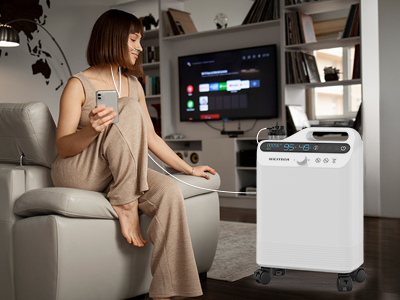30 Apr 2024
Ensuring the safety of oxygen concentrator in the home is crucial to prevent accidents and maintain optimal health for individuals requiring supplemental oxygen.

Proper Placement and Ventilation
A. Ensuring Sufficient Space
Place the oxygen concentrator in a well-ventilated area with sufficient space around it to prevent overheating and ensure proper air circulation.
B. Proper Ventilation Requirements
Keep the oxygen concentrator away from walls or furniture to allow adequate airflow. Avoid placing it in closed or confined spaces that may impede ventilation.
Electrical Safety
A. Avoiding Overloading Circuits
Plug the oxygen concentrator directly into a wall outlet to avoid overloading electrical circuits. Avoid using extension cords or power strips, as they can increase the risk of electrical fires.
B. Using Surge Protectors
Use surge protectors to safeguard the oxygen concentrator from power surges and fluctuations, which can damage the device and compromise safety.
Fire Safety
A. Avoiding Smoking Near Oxygen Concentrators
Smoking near oxygen concentrators is extremely dangerous and can lead to fires or explosions. Encourage smokers to smoke outside and away from the oxygen equipment.
B. Keeping Oxygen Concentrators Away from Heat Sources
Ensure that oxygen concentrators are placed away from heat sources such as stoves, heaters, or direct sunlight, as high temperatures can pose fire hazards.

Preventing Trips and Falls
A. Securing Oxygen Tubing
Secure oxygen tubing along walls or furniture to prevent tripping hazards. Use tubing clips or holders to keep it out of walkways and high-traffic areas.
B. Avoiding Cluttered Areas
Keep the area around the oxygen concentrator clear of clutter to prevent accidents and ensure easy access in case of emergencies.
Maintenance and Cleaning
A. Regular Inspection of Equipment
Regularly inspect the oxygen concentrator for any signs of damage or malfunction. Contact the manufacturer or a qualified technician for repairs or maintenance as needed.
B. Cleaning Filters and Cannulas
Clean or replace filters according to the manufacturer's instructions to ensure proper airflow. Clean nasal cannulas regularly to prevent bacteria buildup and ensure comfort.
Monitoring Oxygen Levels
A. Using Pulse Oximeters
Monitor oxygen levels regularly using a pulse oximeter to ensure that the concentrator is delivering the prescribed amount of oxygen.
B. Understanding Oxygen Saturation Levels
Understand the normal range of oxygen saturation levels and seek medical attention if levels fall below recommended thresholds.
Educating Household Members
A. Teaching Safety Measures
Educate household members about the safe use of oxygen concentrators, including proper handling, storage, and emergency procedures.
B. Emergency Procedures
Ensure that family members know how to respond in case of power outages, equipment malfunctions, or other emergencies involving the oxygen concentrator.
Planning for Power Outages
A. Having Backup Power Sources
Consider investing in backup power sources such as portable generators or battery backup systems to ensure continuous oxygen therapy during power outages.
B. Communicating with Utility Companies
Inform utility companies about the presence of oxygen-dependent individuals in the household to prioritize power restoration in case of outages.
Emergency Preparedness
A. Creating an Emergency Plan
Develop an emergency plan that includes contacting healthcare providers, seeking alternative oxygen sources, and evacuating the home if necessary.
B. Knowing When to Seek Medical Assistance
Recognize signs of oxygen concentrator malfunction or inadequate oxygen delivery and seek prompt medical assistance if needed.
In conclusion, following these safety tips can help ensure the safe and effective use of oxygen concentrators in the home, providing peace of mind for patients and their families.
Keywords: oxygen concentrator
Originally published 30 Apr 2024, updated 30 Apr 2024.